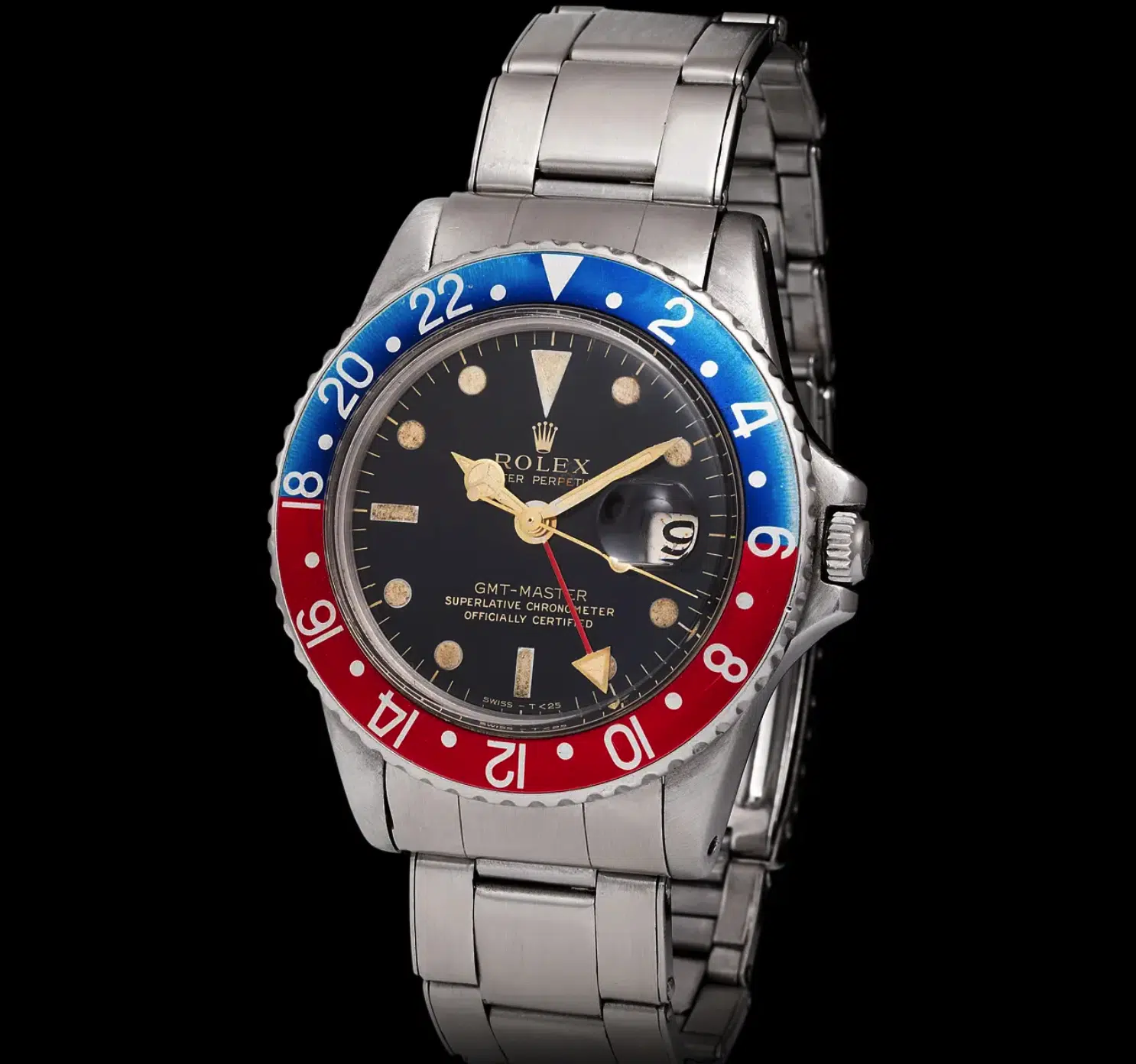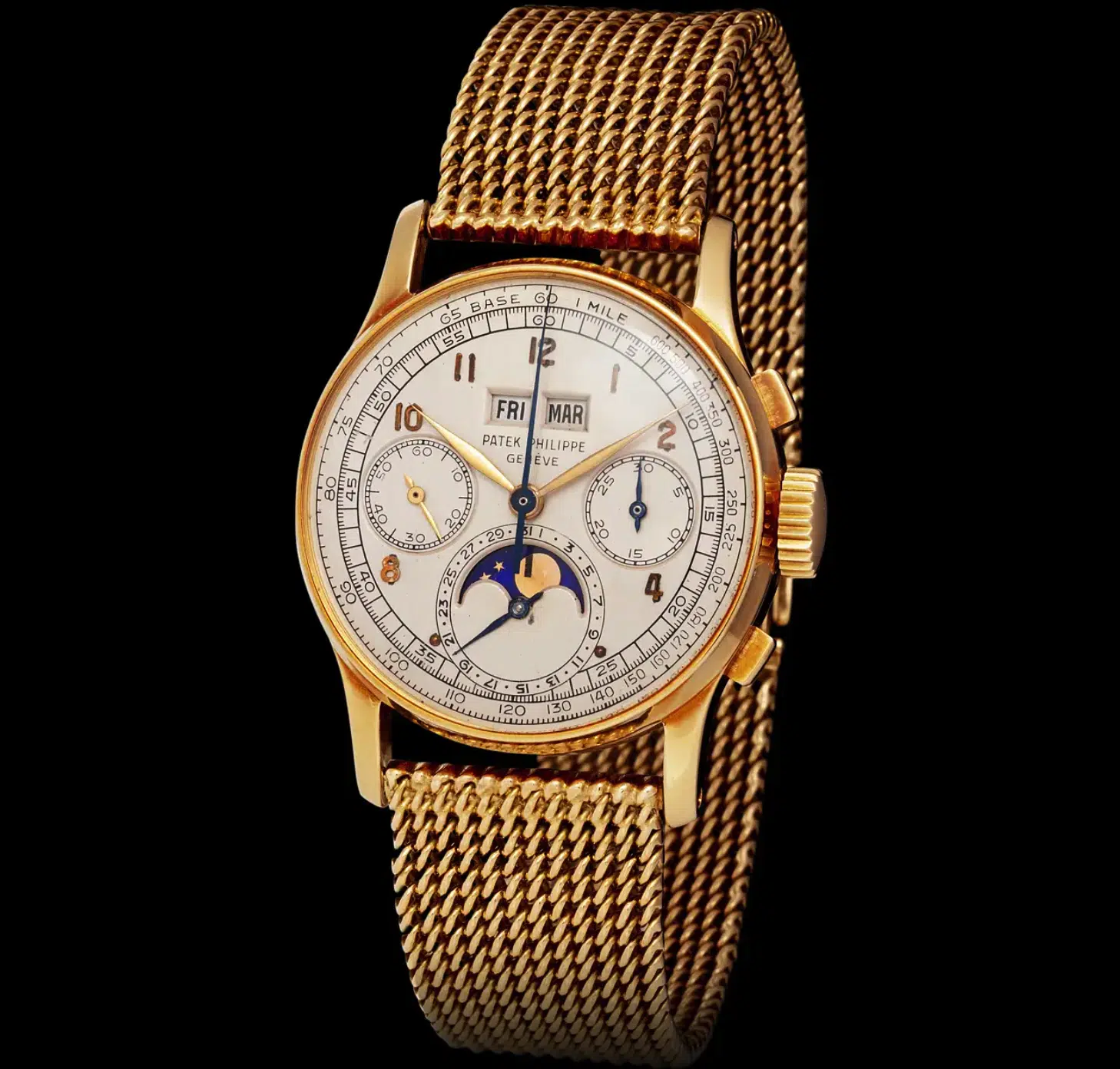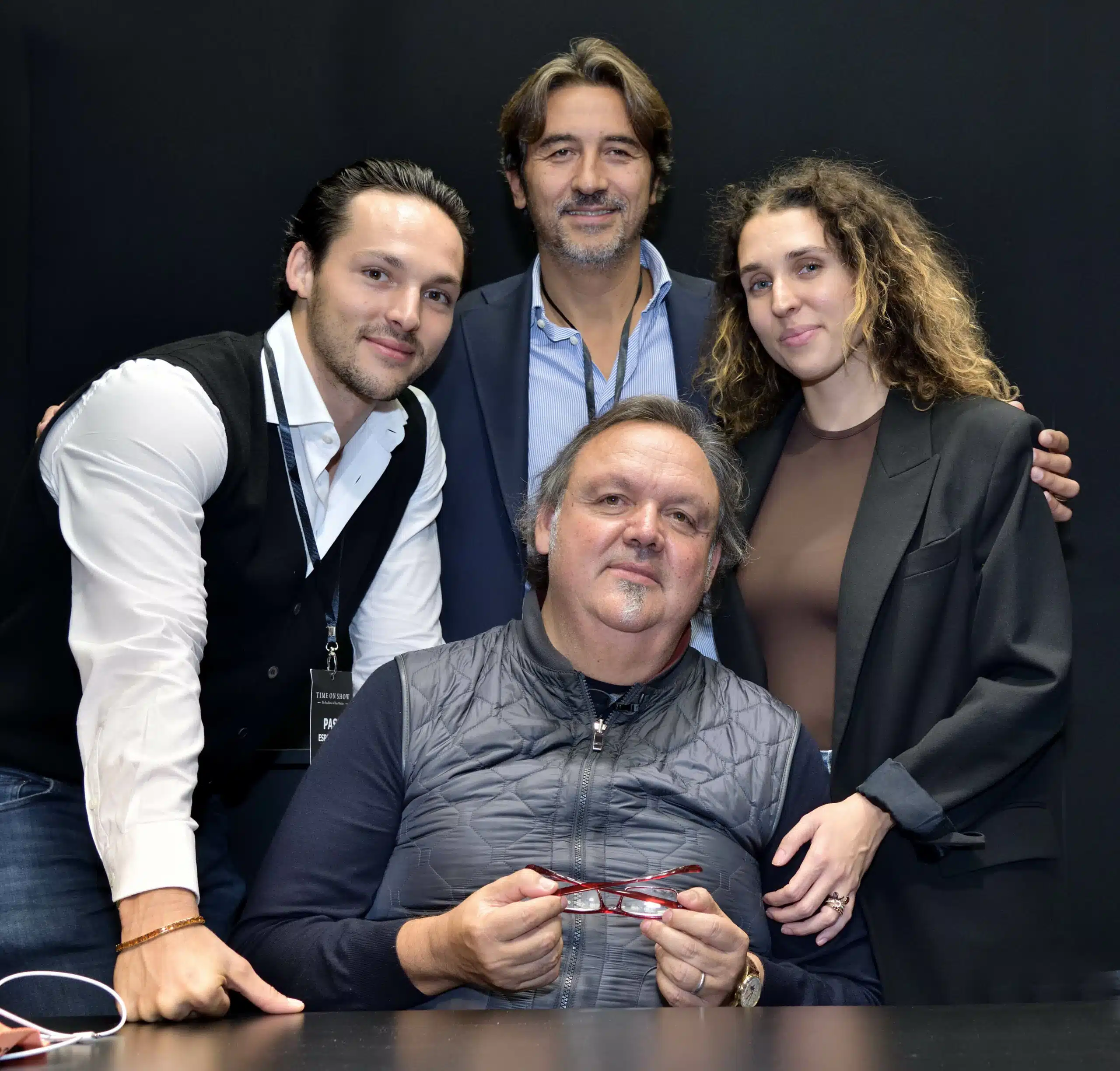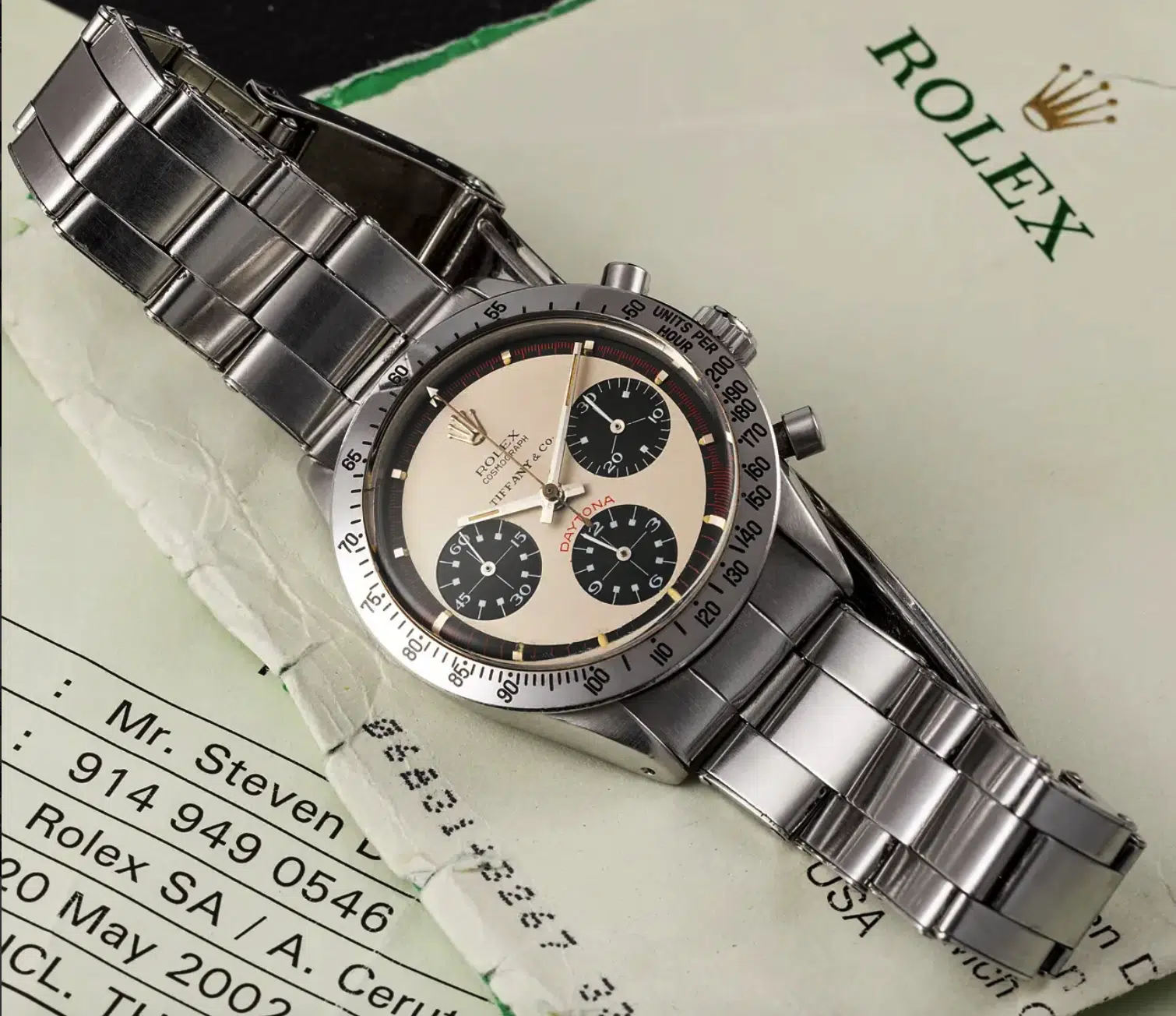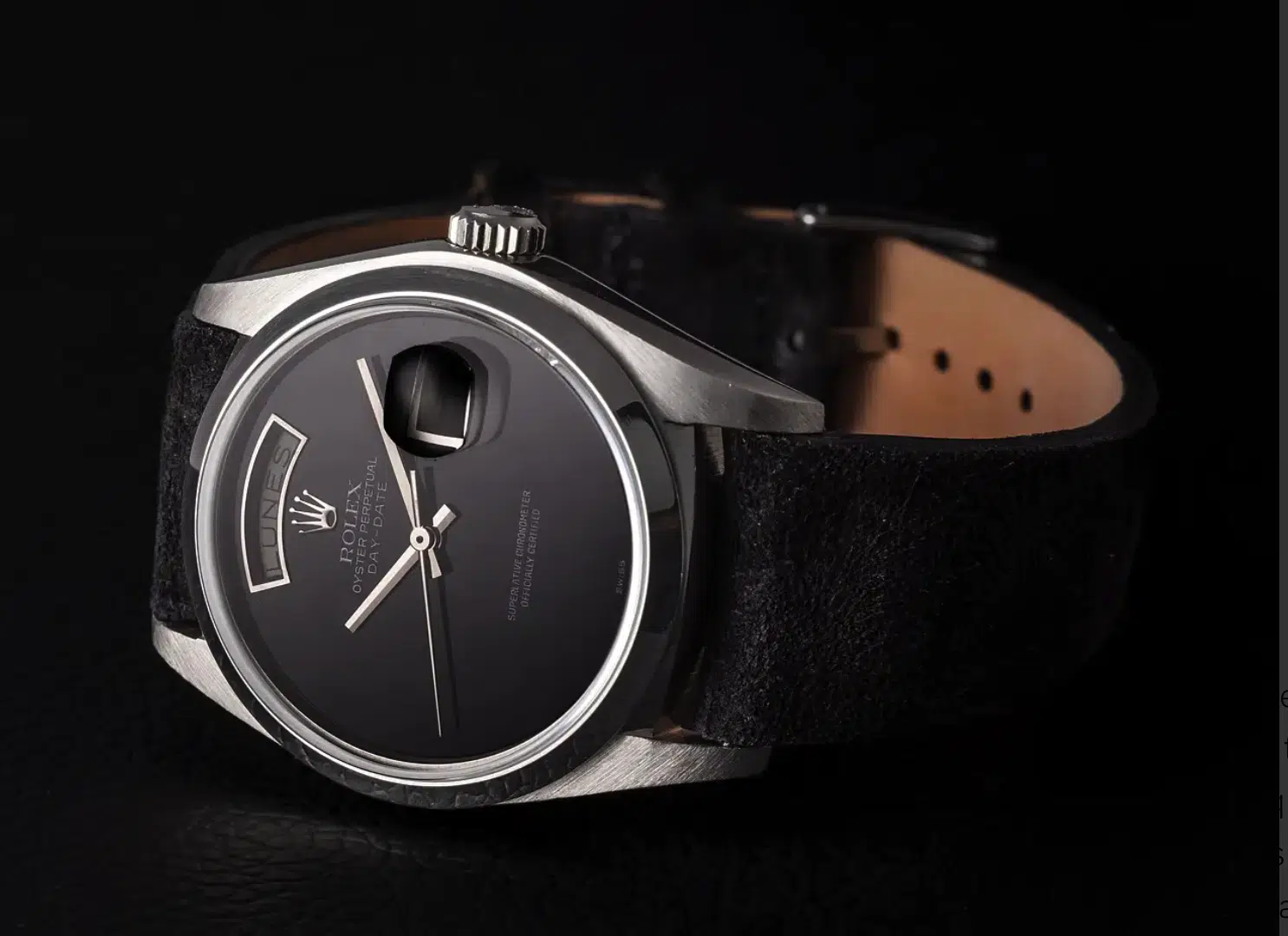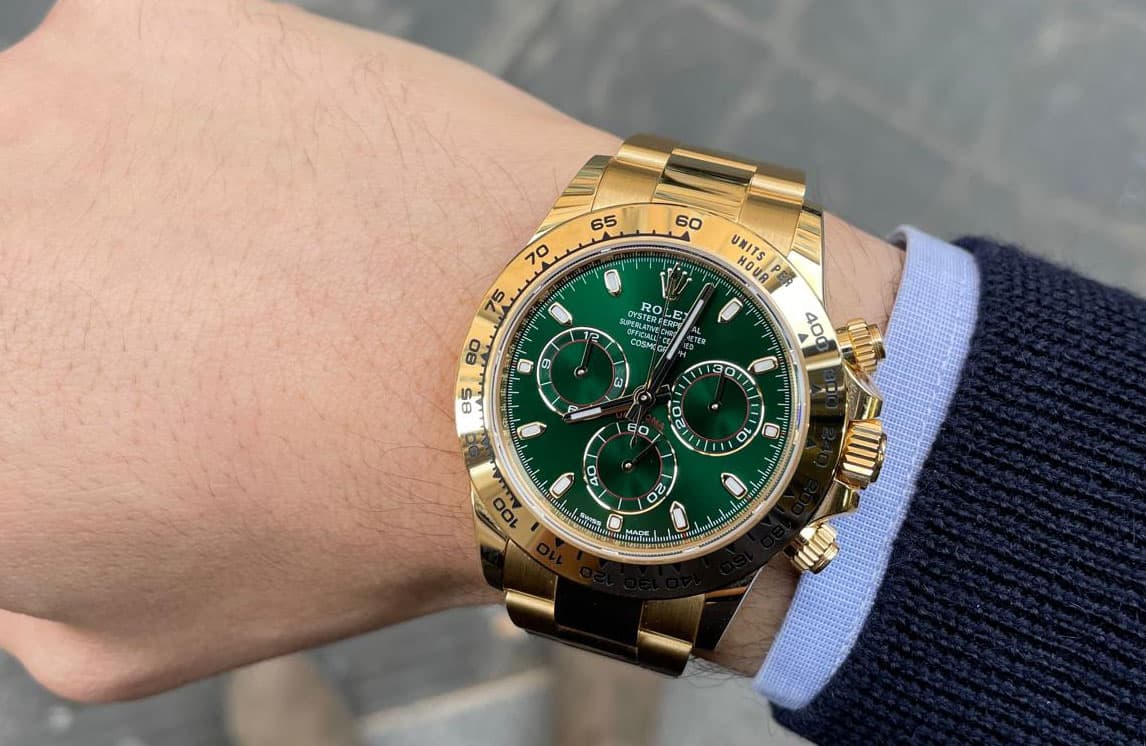Davide Parmegiani, partner since 2019 of Monaco Legend auction house, is known worldwide for his his dual identity as an enthusiast and connoisseur of vintage watches.
His expertise manifests itself both as a curator of collections, carefully selecting each individual piece, and as a consultant for major investments in the world of watches. Likening his role to that of an art curator, Parmegiani studies, researches and selects watches to create authentic cultural heritages for his clients. The same passion and knowledge guide his advice for those who see vintage watches as an investment opportunity.
He loves Milan, considers himself Italian, lives in Monte Carlo but remains fundamentally a citizen of the world. Endowed with an innate politeness and unmistakable Meneghine kindness, he could spend hours telling us about his adventures in the world of hands. We met him during Time On Show 2023, the exhibition moment in Bologna during Auto e Moto d'Epoca, which he strongly wanted and supported.
You have been called an enthusiast, an expert, an antiquarian, a trader, even a super trader. Who is Davide Parmegiani?
"I am basically an enthusiast turned trader who was lucky enough to be in the right place at the right time."
What is the right place?
"I was born in Italy to a family of jeweler traders. From a young age my passion has been watches. It's a story already a bit revisited but it's reality, what I am."
Let's start from where?
"From my family, from Milan, from the neighborhood jewelry store run by my father. Among his many activities, he also bought and sold jewelry from private individuals, and every now and then, on afternoons after school, I would go to the store and happen to see some newly arrived watches for sale as well. I remember the excitement of seeing the first gold eggs, the sports Rolexes... I was always trying to get my hands on them, to study them, to understand them. By the time I was twelve, I had my own little collection of timepieces, headed by a Porsche Design with a black case that was destined to fade shortly thereafter."
The first serious watch?
"A GMT Master in steel. At the time the differences between dart, horn and all that goes with it were not known. It was simply a nice piece, kept well. I bought it with my own money, paying 300,000 lira for it.
The question is a must: did you resell it and if so how much?
(smiling) "Resold yes, at 500,000 lira. Quite a profit, no doubt about it."
Try going back with your memory to the mid-1980s: what watches were you going crazy for at that time?
"Rolex sportsmen, the GMT Master in primis. They were the ones that fascinated me, and in order to document these pieces, I started looking for all the paper catalogs of the early watchmaking auctions that were going on in those years. I would go to flea markets to look for them because there was no auction house willing to send them to me. Then in 1987, thanks to a close friend at the time, I met Giorgio Gregato, who at the time was a legend in collectible watchmaking and had a business set up on Via Cerva in Milan."
It was a time of great turmoil for the world of hands.
"Between 1987 and 1988 I developed my conviction to work in the world of watchmaking."
Finding everyone in agreement?
"Absolutely not. My father was 100 percent refractory and wanted me to take over the family business and do jewelry. I told him I liked Sunday antique markets and wanted to go there and make my own showcase. My dream was America, conventions. I had actually gone just with my father several times to London, to buy jewelry to resell to customers. But it was a completely different thing."
Did you really start with the markets?
"Sure. I went to Bollate, agreed with a local exhibitor who was already selling watches and who was my first partner-whom I always remember with great affection, Valentino Prina of the store le Muse in Via Maroncelli in Milan, a gruff man from Como with a great professional seriousness-I started working with him in Bollate, the first watches in the store, the first customers. From there everything literally "deflagrated" after that."
Had you made the right choice?
"I immediately understood that vintage watchmaking had extraordinary potential, that there was so much to learn and develop. The late 1980s was one of the most vibrant and important moments for Italian entrepreneurship in the entire last century: I met entrepreneurs at that time who were by then super-established and had an irrepressible thirst for collecting watches. They were my first customers in the early 1990s: each of them was buying as many as five watches a week."
A good start.
"On my wrist today I wear a 1518 by Patek Philippe. I bought the first one for 70 million lire: for me it was an exorbitant amount, for my clients peanuts, an "affordable" expense: collectors of the first hour but with great foresight, such as Sandro Fratini, Enrico De Marco, Anna Colombo, Luigi Koelliker, Davide Blei, Luigi Calvasina... that's just to name afew."
Did you go to the i America conventions?
"Of course, I met the biggest dealers of the time there, from Joe DeMesy to Peter Forstner. They were the ones who believed in me, giving me credit and the ability to buy anything. Then I met Daryn Schnipper who was the international watch manager at Sotheby's at the time, and with her I immediately established a great feeling and to this day she is still one of my best friends and colleagues. I did an amazing job there too, going to auctions in the United States, then to Geneva."
In Switzerland in those years, the market revolved around Osvaldo Patrizzi.
"Undoubtedly one of the people who contributed most to 'inventing' the collectible wristwatch market. He also believed in me, gave me confidence, sensed my connections with Italian entrepreneurship."
Comparison between the 1990s and today: were buyers different?
"Yes. There was no Internet and there was much less opportunity to document, to know and to learn. We had to rely on the books of the time, The Time Lords, Golden Hours, then The Dance of the Hours by Alessandro Tagliabue and Tony Zichichi... all these were the history of watchmaking. We relied on people we thought were legitimate, as so many later relied on me and my work. Hence the pleasure of collecting was born: people began to buy watches, even in large numbers. Thus the largest collections in the world were born."
Then what happened?
"The Internet has arrived and everyone has been given the opportunity to acculturate exhaustively, even sometimes excessively."
Excessive?
"Yes, because virtual documentation is sometimes too cold and does not reflect the true essence of the collector's watch, is not able to convey the same passion that comes from holding an object in your hands and assessing its real condition, the real fascination it can convey. The Internet, with its photographs, its videos, is undoubtedly colder in communication. It remains, in any case, the media that has succeeded in introducing this market to the whole world."
The Internet has definitely given a quantitative boost to the number of exchanges. In your experience do you think the quality of them has also increased?
"Yes, absolutely. The possibility of studying punches, cataloging dials, establishing fixed points to delimit the various series, all this has served to "qualify" the objects. The problem is that the Internet gives too much opportunity, to anyone, to self-proclaim themselves an expert, without there then being any real experience in the field. This makes a huge difference and is creating a real rift in the collectible watch market."
A rift?
"There is a current of thought of those who have handled watches for thirty, thirty-five years and consequently created experience by looking at them firsthand, because each watch, its condition, always manages to tell its own story, of the person who owned it, cared for it, of the care they gave it. Internet photos, catalog photos, blog photos, are not able to convey these stories."
In your Monaco Legend auction catalogs, you can actually see the effort to tell, even in words, the story of the pieces offered for sale. This is not something everyone does.
"In fact, it is the reason why in four years your reality is beginning to emerge in the auction world. From the very beginning, I have tried to create a format within which you are able to give a different image of the watch itself, giving importance and based on the history of each individual piece. It is the story that gives character and charisma to the object. Otherwise, you run the risk of only talking about references and money. The watch should be known well before being purchased, it should not all be reduced solely to the presence or absence of a warranty: the historical period in which it was manufactured is fundamental to understanding its value and truthfulness, but it also becomes an enrichment to understanding the entire history of the twentieth century, to which wristwatches are significant witnesses."
Does contextualizing it historically help to understand whether a clock is real or not?
"Absolutely: if you put it in its historical context, you immediately understand its condition is consistent with its history or whether there have not been additions or changes in later eras."
Let's stay on your auction house. Was the creation of Monaco Legend a choice dictated by necessity or foresight?
"Of foresight. If I have to be honest, I had no particular problems or needs. I had been living for nine years in Lugano, Switzerland, where on Via Nassa I had opened my own small business that was working really well. In addition, the quality of life was perfect, I worked by appointment quietly, and I could take care of my relationship with my clients and friends to the best of my ability. I am not interested in selling, no mass-market. I'm interested in creating a collection, a passion, curating certain investments."
Then what happened?
"In recent years I have realized that one-to-one as a business relationship will increasingly fade away: online is increasingly taking over by establishing a different relationship with the everyday. This is theoretically not part of my generation, but I accept it and adapt. Besides, I have two children, of whom I have the moral responsibility for what they will be in the future."
You found yourself thinking about what you could leave to them besides a beautiful collection of Haute Horlogerie that you will have created over the years.
"I thought I wanted to try to see if I could spark in them a passion for what I do. I realized, though, that doing this in my workshop in Lugano, in the one-on-one with customers, would not be a great gift to them. I would be teaching them something that was already old by the time they learned it."
It was necessary to change the focus.
"I began to observe the auction world and thanks to a contact with Claude Cohen of Monaco Legend, a small auction house in Monaco, I received an offer from her that gave me the opportunity to become part of her reality. I talked about it in the family and we chose to enter this new adventure. My son was already working with me for a year and a half, my daughter was in the public relations world, and we made a complete life change and moved to Monte Carlo."
Is the Principality of Monaco your new home, or merely the ideal place for your work?
"I have always felt cosmopolitan and so I have no particular emotional ties to the place where I live. I like being in Milan, I feel Italian, I am and always will be Italian, but I have realized that international realities offer certainly more advantageous work opportunities than exclusively Italian ones. The idea of having an Auction House in Monaco excited me a lot and gave me great energy."
How are you managing this new and complex activity?
"My son is becoming a good Consignment Specialist within the Auction House, which is then the goal I set for him, although his instincts would lead him toward the "pure" dealer's job. He takes his own steps, considering that the job of expert in an Auction House is completely different."
What is the difference between an expert within an auction house and a traditional dealer?
"These are completely different things. For the past four years I have been trying to manage to the best of my ability the collections entrusted to me by clients, with whom I often have more than a decade-long relationship and thus a relationship based on mutual esteem and trust. Alongside this, I work so that new clients, especially young ones, approach watch auctions: they are the collectors of tomorrow, the ones who will keep the world of hands vital."
How do you reconcile the soul of the dealer, the antiquarian historian, with that of the expert within an auction house?
"They don't go against each other, especially since I immediately accepted the idea of not selling my personal watches at auction. Monaco Legend has a dual license, both as an auction house and as a private sell. We can, therefore, do private sales as well. As a result, together with my partner, we agreed to equip Monaco Legend with its own stock of watches for private sell, so as to give the customer the opportunity to buy a watch even in private. I think that today the auction house has a kind of 360-degree function with respect to the customer: if its service is quality and professional, it can satisfy any of his needs."
Does the customer not only have a need to buy or sell a watch?
"Our work is much broader. We can manage or supplement a collection, advise on the best purchase based on the client's own needs, even direct on purchases to be made at other auction houses. Basically that's what I've been doing all my life; I'm definitely one of the best clients that Christie's, Sotheby's, Phillips, and Antiquorum have. I have always bought from them both for myself and for my clients."
Do you continue to do it today as you used to?
"I do it as an advisor, I don't do stock on a personal level anymore, but for Monaco Legend: when I see something interesting sold by other auction houses at an attractive price, I take it and put it in our stock to resell it all over the world. I have to say that's the job I do best."
Theoretically your work has not changed that much.
"It has changed only in the function of the auction house: making the selection, organizing the auction, and creating the catalog. For the latter I pay a great deal of attention, because it's not like inone-to-one that you have the customer in front of you and you can calmly explain the clock to him, in the auction sale the buyer is documented in the printed or online catalog and falls in love with an object only if you've been good at telling about it right in the catalog."
What was the spring that allowed Monaco Legend to establish itself so quickly in the auction world?
"Definitely the clients' trust in me: the reputation earned with them over many years of work has made our work develop really fast. The Achilles' heel of auction houses today is being lacking in market experts: professionals, very good guys who work with passion, but who don't have 35 years of experience on their shoulders, partly because if they did they would probably have chosen to be dealers on their own. It's not good to get the experience inside auction houses, subject to special exceptions like my son growing up next to me, or Edoardo Bolla who works with Aurel Bacs and is growing in legitimacy, otherwise they really need a lot of time to acquire the notions and legitimacy necessary to attract buyers and sellers."
Does this mean you never make mistakes?
(smiling) "No, like everyone we make mistakes and we are the first to admit it. I always work in total good faith and in fact we accept collaboration or criticism to help us correct if there is something wrong or to improve what we do. For example, in the penultimate auction we removed a couple of pieces from the sale because with the help of professional friends, we realized they were not regular. I am at Monaco Legend to do what I have done for thirty-five years: to create good collections and to have a good human and professional relationship with collectors."
Patek Philippe, 35 years in the same collection, perhaps unique and extremely well-preserved, square-shaped platinum wristwatch, central seconds and hinged case, published in "The Lords of Time - 300 fabulous vintage wristwatches. Platinum case, year 1920.
Estimate: € 250.000 - 500.000
Sold BY MONACO LEGEND IN OCTOBER 2023 FOR €754,000
Is there more adrenaline in buying or selling?
"In buying! I would just buy! Fortunately, I'm friends with people like Auro Montanari or Sandro Fratini, whom I've forced over time to buy everything I didn't buy myself."
An example?
"It is neither logical nor ethical for me to purchase a watch that I auction at Monaco Legend. So, since I cannot do so, I sometimes 'force' Auro to buy it, as I know it is a particularly rare or valuable item. For example, he "bought" under my pressure the Patek Philippe carré central seconds in platinum that I had the honor and pleasure of handling in the last Monaco Legend auction: a crazy watch that I had been chasing for over thirty years, owned by the father of a very dear one of mine, published in the book I Signori del Tempo written by Jader Barracca, Giampiero Negretti, Franco Nencini. A milestone of collecting and watchmaking, deserving a place of honor in a museum, which turned 100 years old this year...it was to remain "for life" in the collection of a friend: "you can't not buy it" response "but that watch will make a figure" I reply "what it will make is what the market decides it is worth today, because that is what happens and must happen when it is sold at auction.""
Interesting this last talk: there has long been a lot of talk about whether or not reserve prices are appropriate.
"My goal is to get to auctions without reserve prices-that would be the best thing for all collecting. It is the market that makes the price and it is the market that makes the value."
The problem is that the seller sometimes does not feel protected from what may happen during the sale.
"I understand that, but it is a mistake. A fear that slowly, over time the marketer will overcome. If the watch is beautiful and is professionally managed with good marketing by the person who has to sell it, the result is that it will be visible all over the world: we are old for online but online is very young for us, consequently the reality is that today everyone sees everything."
Will the market always be able to express the right price?
"Yes, and when a piece goes unsold, there are two reasons: it was not described and explained properly; it had too high a reserve price. The fearful or too greedy seller is the one who damages the auction market, which does not reflect a true picture of the market. We have to reconcile the greed of sellers with economic conditions that are at the mercy of international situations, making people be stimulated to buy. If we have a 94 percent true and established purchase rate, we also owe it to an important fact: a conservative estimate entices people to come to the auction, the reality is that a more aggressive valuation could also be made, while raising this value too much discourages selling."
An example is urgently needed.
"In the last auction I offered for sale a Day-Date in platinum onyx dial with an ultra conservative estimate at 20,000 euros. I was able to do this because the client trusted me and Monaco Legend's selling skills. If I had put it near the 124,000 euros that was the actual adjudication, I would have only achieved to scare off possible buyers and maybe the watch would not even have reached that important value. Also, I think if it had been unreserved, it would have made even more: it was an exceptional watch."
Is vintage watchmaking passion or investment?
"It is born as a passion. If you approach it solely for investment, it's difficult for the watch to pay you back: you have to convey passion, emotion. It is not a short-term market suitable for short-term speculators. You should not talk about monthly or annual percentage appreciation. To those who ask me how much a particular watch will be worth in a year's time, I always say, "approach some stock market investments, right now they are having very good results, but above all you will have more established and secure satisfactions." The watch does not give certainties, today the market is large and important because there are so many enthusiasts scattered all over the world, not because there are speculators. These move in and out quickly, on the contrary, those who cherish and agree to keep a collector's piece, for long enough to pay it back, will only ever have satisfaction. One law is what drives the market: the lust for possession."
The lust for possession?
"If you buy a nice watch and keep it, there will always be someone else who will want it and to be able to take it away from you they will be willing to pay more than you paid for it. Which then, you may have realized, for me to sell an object I care about is really a pain. Americans say "Let it go," let it go, but for me it's really a pain to alienate certain watches that I care about ... it may sound absurd but my son suffers more than I do."
